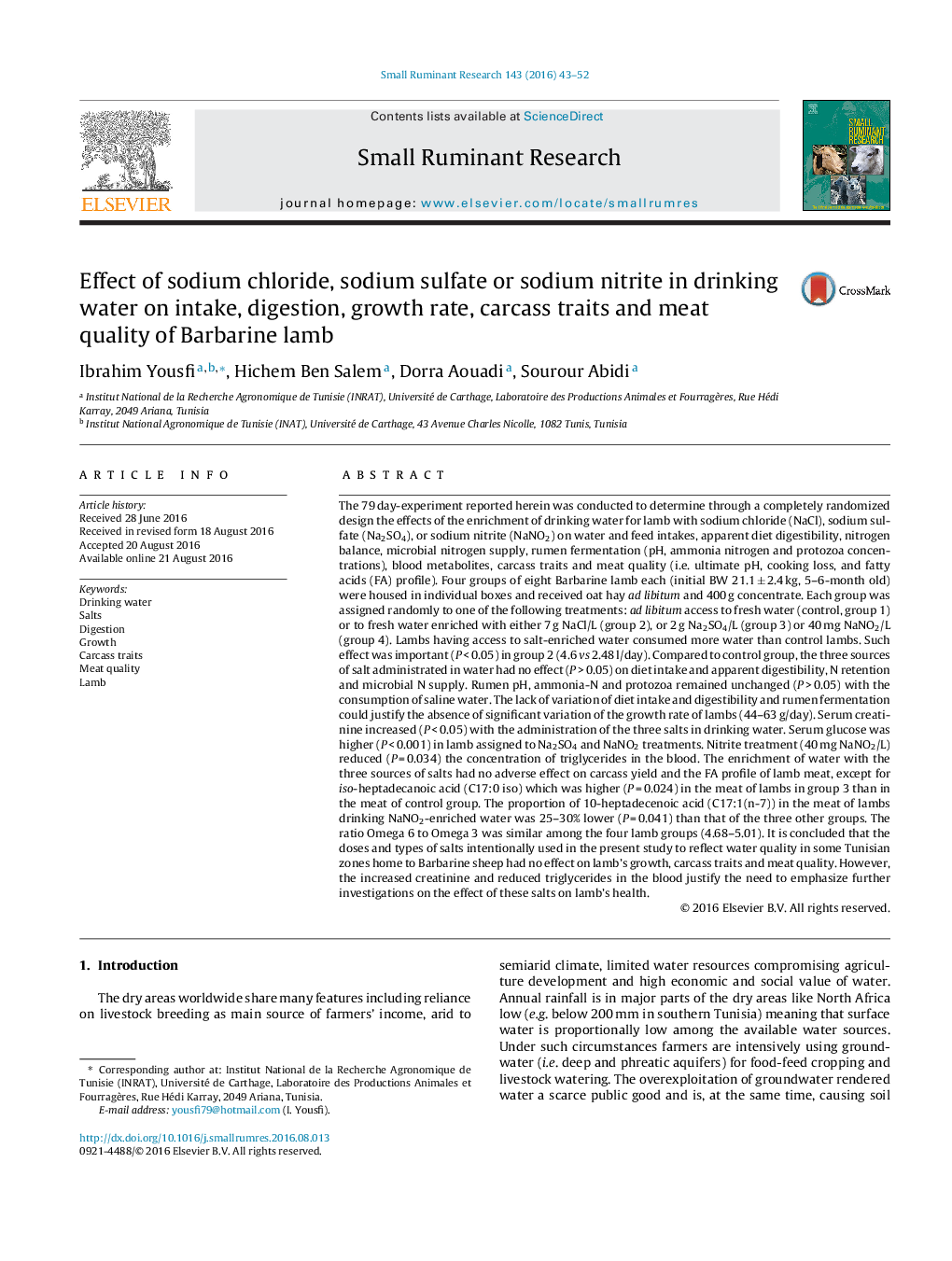| Article ID | Journal | Published Year | Pages | File Type |
|---|---|---|---|---|
| 2456639 | Small Ruminant Research | 2016 | 10 Pages |
Abstract
The 79 day-experiment reported herein was conducted to determine through a completely randomized design the effects of the enrichment of drinking water for lamb with sodium chloride (NaCl), sodium sulfate (Na2SO4), or sodium nitrite (NaNO2) on water and feed intakes, apparent diet digestibility, nitrogen balance, microbial nitrogen supply, rumen fermentation (pH, ammonia nitrogen and protozoa concentrations), blood metabolites, carcass traits and meat quality (i.e. ultimate pH, cooking loss, and fatty acids (FA) profile). Four groups of eight Barbarine lamb each (initial BW 21.1 ± 2.4 kg, 5-6-month old) were housed in individual boxes and received oat hay ad libitum and 400 g concentrate. Each group was assigned randomly to one of the following treatments: ad libitum access to fresh water (control, group 1) or to fresh water enriched with either 7 g NaCl/L (group 2), or 2 g Na2SO4/L (group 3) or 40 mg NaNO2/L (group 4). Lambs having access to salt-enriched water consumed more water than control lambs. Such effect was important (P < 0.05) in group 2 (4.6 vs 2.48 l/day). Compared to control group, the three sources of salt administrated in water had no effect (P > 0.05) on diet intake and apparent digestibility, N retention and microbial N supply. Rumen pH, ammonia-N and protozoa remained unchanged (P > 0.05) with the consumption of saline water. The lack of variation of diet intake and digestibility and rumen fermentation could justify the absence of significant variation of the growth rate of lambs (44-63 g/day). Serum creatinine increased (P < 0.05) with the administration of the three salts in drinking water. Serum glucose was higher (P < 0.001) in lamb assigned to Na2SO4 and NaNO2 treatments. Nitrite treatment (40 mg NaNO2/L) reduced (P = 0.034) the concentration of triglycerides in the blood. The enrichment of water with the three sources of salts had no adverse effect on carcass yield and the FA profile of lamb meat, except for iso-heptadecanoic acid (C17:0 iso) which was higher (P = 0.024) in the meat of lambs in group 3 than in the meat of control group. The proportion of 10-heptadecenoic acid (C17:1(n-7)) in the meat of lambs drinking NaNO2-enriched water was 25-30% lower (P = 0.041) than that of the three other groups. The ratio Omega 6 to Omega 3 was similar among the four lamb groups (4.68-5.01). It is concluded that the doses and types of salts intentionally used in the present study to reflect water quality in some Tunisian zones home to Barbarine sheep had no effect on lamb's growth, carcass traits and meat quality. However, the increased creatinine and reduced triglycerides in the blood justify the need to emphasize further investigations on the effect of these salts on lamb's health.
Related Topics
Life Sciences
Agricultural and Biological Sciences
Animal Science and Zoology
Authors
Ibrahim Yousfi, Hichem Ben Salem, Dorra Aouadi, Sourour Abidi,
